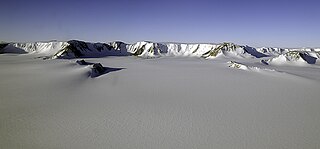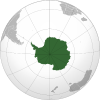Related Research Articles

The Shackleton Range is a mountain range in Antarctica. Rising at Holmes Summit to 1,875 metres (6,152 ft), it extends in an east–west direction for about 160 kilometres (99 mi) between the Slessor and Recovery glaciers.

Alexandra Mountains is a group of low, separated mountains in the north portion of Edward VII Peninsula, just southwest of Sulzberger Bay in Marie Byrd Land, Antarctica. Discovered in January–February 1902 by the British National Antarctic Expedition during an exploratory cruise of the Discovery along the Ross Ice Shelf. Named for Alexandra, then Queen of the United Kingdom.
Gordon Glacier is an Antarctic glacier of at least 24 nautical miles in length flowing in a northerly direction beginning in the Crossover Pass, flowing through the Shackleton Range to finally meet the Slessor Glacier. The glacier was first mapped in 1957 by the CTAE, and named after George Patrick Pirie-Gordon, 15th Laird of Buthlaw, who was a member of the Committee of Management and treasurer of the CTAE between 1955 and 1958.
Blaiklock Glacier is a glacier 16 nautical miles (30 km) long, flowing north from Turnpike Bluff, then northwest to Mount Provender and Mount Lowe in the western part of the Shackleton Range, Antarctica. It was first mapped in 1957 by the Commonwealth Trans-Antarctic Expedition (CTAE), and named for Kenneth V. Blaiklock, the leader of the advance party of the CTAE in 1955–56 and a surveyor with the transpolar party in 1956–58.
Bowden Névé is a névé in Antarctica about 20 nautical miles (40 km) wide, lying southward of Mount Miller between the Queen Elizabeth Range and the Queen Alexandra Range. It was observed in 1958 by the New Zealand Southern Party of the Commonwealth Trans-Antarctic Expedition (CTAE) (1956–58) and named for Charles M. Bowden, Chairman of the Ross Sea Committee which organized the New Zealand party of the CTAE.
Otter Highlands is a group of peaks and ridges extending NW-SE for 17 nautical miles (31 km) from Mount Lowe to Wyeth Heights, located west of Blaiklock Glacier and forming the west end of the Shackleton Range. Surveyed by the Commonwealth Trans-Antarctic Expedition in 1957. Named by the United Kingdom Antarctic Place-Names Committee (UK-APC) in 1972 after the De Havilland Otter aircraft which supported the CTAE.

Coalseam Cliffs are rock cliffs forming the north-western part of Mount Faraway in the Theron Mountains. They were first mapped in 1956–57 by the Commonwealth Trans-Antarctic Expedition (CTAE), and so named because a coal seam was found when members of the CTAE made an aircraft landing there in 1957.
Cranfield Peak is a peak, 2,850 metres (9,350 ft) high, standing 6 nautical miles (11 km) south of Mount Weeks in the Queen Elizabeth Range. Tentatively named "Sentinel Peak" by the New Zealand Southern Survey Party of the Commonwealth Trans-Antarctic Expedition (CTAE) (1956–58), who visited it in 1958, it was renamed for Flying Officer W.J. Cranfield who, as one of the pilots operating with the CTAE, gave considerable assistance to the surveying party in this area.
Fuchs Dome is a large ice-covered dome rising over 1,525 metres (5,000 ft), between Stratton Glacier and Gordon Glacier in the central part of the Shackleton Range, Antarctica. It was first mapped in 1957 by the Commonwealth Trans-Antarctic Expedition (CTAE) and named for Sir Vivian E. Fuchs, leader of the CTAE 1955–58.
Mount Frontz is a prominent mountain in the western Wisconsin Range, Antarctica. It is 2,010 metres (6,600 ft) high, and rises between Mount Vito and Griffith Peak on the east side of Reedy Glacier. It was mapped by the United States Geological Survey from surveys and U.S. Navy air photos, 1960–64, and was named by the Advisory Committee on Antarctic Names for Lieutenant Commander Leroy Frontz, an aircraft commander during U.S. Navy Operation Deep Freeze 1966 and 1967.
Glen Glacier is a glacier at least 7 nautical miles (13 km) long, flowing south in the Shackleton Range of Antarctica to join Recovery Glacier to the west of the Read Mountains. It was first mapped in 1957 by the Commonwealth Trans-Antarctic Expedition (CTAE) and named for Alexander Richard "Sandy" Glen, a member of the Committee of Management of the CTAE, 1955–58.
Goldsmith Glacier is a glacier flowing west-northwest through the Theron Mountains of Antarctica, 6 nautical miles (11 km) south of Tailend Nunatak. It was first mapped in 1956–57 by the Commonwealth Trans-Antarctic Expedition (CTAE) and named for Rainer Goldsmith, medical officer with the advance party of the CTAE in 1955–56.
The Morris Hills are a scattered group of hills 6 nautical miles (11 km) northeast of Petersen Peak, in the La Grange Nunataks of the north-central Shackleton Range, Antarctica. They were first mapped in 1957 by the Commonwealth Trans-Antarctic Expedition (CTAE), and photographed in 1967 by the U.S. Navy. The hills were named by the UK Antarctic Place-Names Committee for Leslie F. Morris, a member of the Royal Society International Geophysical Year Expedition at Brunt Ice Shelf, who in 1957 spent several weeks helping with the final preparations for the CTAE transpolar journey.
Mount Moa is a mountain rising above 2,000 metres (6,600 ft) at the northern end of the Churchill Mountains in Antarctica. Located above Kiwi Pass and at the southern end of Kent Plateau, it was named after an extinct and flightless bird species in New Zealand, the moa. The naming is in association with the adjacent feature, Kiwi Pass, which was named after a familiar nickname for New Zealanders, the kiwi being also a species of flightless bird found only in New Zealand.
The Lister Heights are rock heights on the east side of Stratton Glacier, 4 nautical miles (7 km) southwest of Flat Top in the western part of the Shackleton Range, Antarctica. They were first mapped in 1957 by the Commonwealth Trans-Antarctic Expedition (CTAE) and named for Hal Lister, a glaciologist with the transpolar party of the CTAE in 1956–58, and leader at the expedition's advance base, South Ice, in 1957.
Mount Skidmore is a mountain on the east side of the mouth of Stratton Glacier in the Shackleton Range. It was first mapped in 1957 by the CTAE, and it was photographed in 1967 by U.S. Navy trimetrogon aerial photography. It was named by the United Kingdom Antarctic Place-Names Committee (UK-APC) for Michael J. Skidmore, a British Antarctic Survey (BAS) geologist at the Brunt Ice Shelf between 1966 and 1969 who worked in the Shackleton Range from 1968 to 1969.
La Grange Nunataks is a scattered group of nunataks extending west for 22 nautical miles (41 km) from the mouth of Gordon Glacier, on the north side of the Shackleton Range, Antarctica. They were first mapped in 1957 by the Commonwealth Trans-Antarctic Expedition (CTAE), and were photographed in 1967 by U.S. Navy aircraft. They were named by the UK Antarctic Place-Names Committee for Johannes J. La Grange, a South African meteorologist with the CTAE.
The Lewis Chain is a chain of four rock nunataks on the west side of Gordon Glacier in the Shackleton Range of Antarctica. It was first mapped by the Commonwealth Trans-Antarctic Expedition (CTAE) in 1957, and was photographed by the U.S. Navy in 1967. The chain was named by the UK Antarctic Place-Names Committee for Squadron Leader John H. Lewis, Royal Air Force (RAF), senior pilot of the RAF contingent of the CTAE, 1956–58.
The Ark is a rock summit, 1,790 m (5,870 ft), in the central part of the Read Mountains, in the Shackleton Range in Antarctica. First mapped in 1957 by the CTAE. The name, given by the United Kingdom Antarctic Place-Names Committee (UK-APC), is descriptive of its shape when viewed from the west.
Mount Macdonald is a peak rising to 3,630 metres (11,910 ft) surmounting the massive N-S trending ridge between Ludeman Glacier and Pain Neve in the Commonwealth Range. Named by New Zealand Geological Survey Antarctic Expedition (NZGSAE) (1961–62) for the Hon. T.L. Macdonald, who was Minister of External Affairs and of Defence when the Commonwealth Trans-Antarctic Expedition (CTAE) (1956–58) was being planned and who took a prominent part in obtaining New Zealand participation in the Antarctic.
References
- ↑ "Greenfield, Mount". Geographic Names Information System . United States Geological Survey, United States Department of the Interior . Retrieved 7 May 2012.
![]() This article incorporates public domain material from "Greenfield, Mount". Geographic Names Information System . United States Geological Survey.
This article incorporates public domain material from "Greenfield, Mount". Geographic Names Information System . United States Geological Survey.
